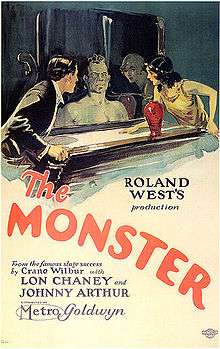The Monster (1925 film)
| The Monster | |
|---|---|
 Theatrical release poster | |
| Directed by | Roland West |
| Produced by |
W. L. Heywood Roland West |
| Written by |
Crane Wilbur (play) Roland West Willard Mack Albert Kenyon |
| Starring |
Lon Chaney Johnny Arthur Gertrude Olmstead |
| Cinematography | Hal Mohr |
| Distributed by | Metro-Goldwyn Pictures Corporation |
Release dates |
|
Running time | 86 minutes |
| Country | United States |
| Language |
Silent film English intertitles |
The Monster is a 1925 silent horror comedy directed by Roland West, based on the play by Crane Wilbur, and starring Lon Chaney and Johnny Arthur, and is remembered as an antecedental Old Dark House movie, as well as a precedent to many subgenre of horror films. The film has been shown on TCM network with an alternate, uncredited musical score.
Synopsis
Johnny Goodlittle (Johnny Arthur), an aspiring detective, enters an abandoned sanitorium while investigating a disappearance. Here, he discovers that Ziska, a renegade mad doctor, has taken over the asylum. Now Ziska has captured Betty, Johnny's romantic interest, to use in his mad experiments.
John Bowman, a wealthy farmer, is kidnapped one night after two mysterious men lure his car off the road. When the wreckage is discovered the next day, constable Russ Mason (Charles Sellon) forms a search party with Amos Rugg (Hallam Cooley) and Johnny Goodlittle.
Amos and Johnny work at the general store in Danburg. They are in love with Betty Watson (Gertrude Olmstead), the storeowner's daughter. Attempting to woo Betty, Amos invites her on a drive in the country. Meanwhile, Johnny has followed a mysterious stranger to the country. The strange man has lured Amos' car off the road and kidnapped the couple. Johnny accidentally enters a hidden tunnel, and all three end up at Dr Edwards' Sanitarium.
Once inside, they are greeted by Dr Gustave Ziska (Lon Chaney), who introduces Rigo (George Austin), Caliban (Walter James), and Daffy Dan (Knute Erickson), his patients. Ziska explains that he took control of the asylum after it had closed. After many attempts to expunge the three hostages, they are captured and sent to a dungeon, wherein Johnny finds Dr Edwards and John Bowman kidnapped by Ziska and his cronies.
Dr Edwards tells Johnny that Ziska, Caliban, Rigo and Daffy Dan were once his patients at the sanitarium. Ziska had been a great surgeon who went mad and began to perform unorthodox operations. He now intends to perform experiments on Betty and Amos, to discover the secret of eternal life.
Amos and Johnny are captured and brought to Ziska's laboratory, where Betty lies fastened to a surgical bed. Amos is strapped to the "death chair" and connected to Betty through a transducer, which will exchange their souls. Johnny eludes Ziska's henchmen and escapes to the roof, sending up flares which are seen by policemen investigating the wreckage of Amos' car.
Having escaped, Johnny masquerades as Rigo and begins to assist the doctor. He frees Betty and Amos and straps Ziska to the death chair. Caliban appears and, mistaking the figure in the chair as Amos, activates the transducer, removing Ziska's soul from his body. Because there is no one on the surgical bed, there is no soul to complete the exchange, and he is rendered lifeless.
Realizing his mistake, Caliban is distracted and Johnny captures him. The policemen enter the laboratory to find that Johnny has successfully apprehended the madmen and located the missing persons. This is enough to gain him respect as an amateur detective, and to win Betty's heart and hand.
Cast
- Lon Chaney as Gustave Ziska
- Johnny Arthur as Johnny Goodlittle
- Gertrude Olmstead as Betty Watson
- Hallam Cooley as Amos Rugg
- Charles Sellon as Russ Mason, a constable
- Walter James as Caliban
- Knute Erickson as Daffy Dan
- George Austin as Rigo
- Edward McWade as Luke Watson, Betty's father
- Ethel Wales as Mrs Watson, Betty's mother
- Herbert Prior as Doctor Edwards
- Matthew Betz as Detective Jennings
- In the play's 1933 revival, DeWolf Hopper played Dr Ziska, one of his last roles.
- Walter James also played Caliban in the 1922 play.
Genre
The genre and cinematic style of The Monster is ambiguous. Though preceded by several films such as The Cabinet of Dr. Caligari, it stands as an early mad scientist movie, and is arguably the first to feature the mad doctor with a cabal of minions to do his bidding. The picture also stands an early example of an '"old dark house" movie, even preceding The Old Dark House (1932) itself.
A distinguishing quality of The Monster which deviates from most horror films is its use of subtle humour in serious or dramatic situations. As in many conventional comedies, the protagonist Johnny Goodlittle is a comic relief character. He is also an early example of an effeminate, cowardly hero, as the actor Johnny Arthur usually played.
The style of humor is often ironic or a running gag, such as Johnny's faith in candles and flares to call for help, or reliance on his "ingenuity" to overcome dire circumstances. However, unlike many contemporary horror movies that involve comedic elements, the dramatic scenes and eerie effects of The Monster are not intended to be campy (cf. The Toxic Avenger (1985)), nor are they the crux of the plot (cf. The Cat and the Canary (1939)).
External links
| Wikiquote has quotations related to: The Monster (1925 film) |
- The Monster at the Internet Movie Database
- The Monster at SilentEra with still photo from the film
- The Monster at AllMovie
- The Monster on TCM's Screened Out film spotlight.